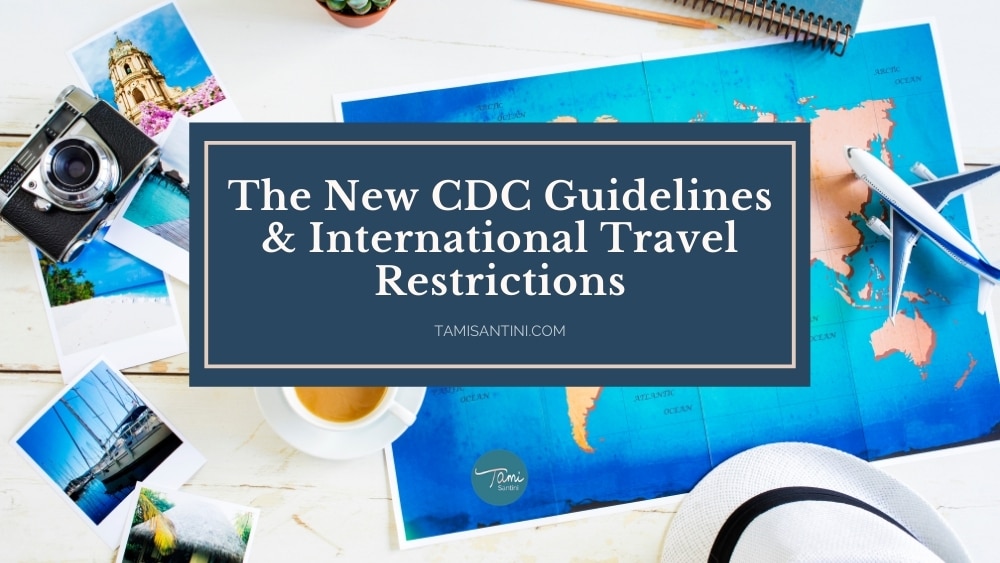On January 12, 2021, we learned about new COVID-19 testing rules for international passengers arriving in U.S. airports starting Jan. 26, 2021.
As a wedding business coach and a travel advisor, it is important for me to stay abreast of policies to ensure my clients and my students have the knowledge needed to make decisions regarding traveling outside our country.
To make your life easier, here is a quick overview of the new Coronavirus travel restrictions for entering the U.S. along with some frequently asked questions.
Beginning Jan. 26, passengers traveling to the United States by air (including U.S. citizens returning home from trips abroad) must present negative results from a COVID-19 test when they check in for those U.S.-bound flights. They must have taken that test within 3 days of the scheduled departure date and time for that flight to the United States. Without those results, they will not be allowed to board the flight.
Both molecular tests (nasal swabs) and rapid antigen (saliva) tests will be accepted.
As an alternative to the test results, passengers may show proof that they’ve recovered from COVID-19 within the past 3 months (e.g., a letter from a healthcare provider). If you’ve recovered from COVID-19 more than 90 days from your date of travel, you will be required to be tested within 3 days of your scheduled departure.
At the time of writing this article, January 15, 2021, proof of COVID-19 vaccination will NOT be accepted in lieu of the test results.
Here’s a Q&A page from the U.S. Centers for Disease Control and Prevention with more details.
Many resorts and hotels will offer testing on-site, so you can take the test and receive your results within the 3-day window before your flight home to the United States. A travel advisor like myself will make sure you have the best options and can know what to expect.
Some destinations and resort/hotel companies are planning to offer free testing for your return flight home. If free tests aren’t available on your trip, a travel advisor can check with your travel insurer to see if your policy will cover the testing costs.
If your test results are positive, you won’t be allowed to board your scheduled flight. However, your travel insurer may cover the cost of staying longer in the destination so you can repeat the test to prevent a “false positive”, (or you may need to quarantine there if you have COVID-19 and the insurer may cover those costs as well). Also, some destinations such as the Dominican Republic are offering free COVID-19 coverage to all visitors who arrive by air and stay in a hotel, so that coverage may cover some of these costs too.
Under these new rules, your results must come from a test that was taken within 3 days (72 hours) of your scheduled departure date and time, even if the departure is delayed so that your test falls beyond those 72 hours. It’s important to work with a travel professional and get the best options for travel insurance so that trip delay or interruption costs are covered under your policy.
I know this can all be unsettling. Believe me, I want people to travel! As a travel professional, we don’t get paid until people travel, so I’m certainly not writing this to scare you off, but I need to be upfront so you can make an informed decision.
If you are planning a trip to Mexico or the Caribbean, I believe you will experience a seamless and easy process at the majority of resorts that a travel pro would recommend.
Here’s a summary of what you can expect if you decide to travel to a resort in Mexico or the Caribbean with these new CDC rules:
- Some resorts are offering complimentary tests on-site to make the process easy so you can continue enjoying your vacation. If it isn’t included, you can expect to pay up to $250 for your test
- Some resorts are offering complimentary quarantine stays for those who test positive, others are offering 50% off. Some will not offer any help and this is where you would rely on having proper travel insurance
- You’ll have a great vacation with safety protocols that will make you feel safe and secure
I’m going to throw in my opinion. If you are concerned but still want to travel, I recommend you get tested prior to leaving for your trip, even if the destination doesn’t require it.
Here’s my logic on this, I would much rather have you find out that you can’t go than get there and be stuck. I believe a negative test just before you depart will give you peace of mind that you’ll likely test negative in destination.
Let me give you an example: I have a destination wedding group heading to Mexico in March for a wedding. Most guests are staying for four nights and arriving on a Thursday. So, they would be tested on Friday afternoon in order to be within the required 72-hour testing window. If they get a test a few days prior for their trip, the two tests would literally be less than a week apart. Make sense?
I cannot stress enough to work with a travel professional to book an international vacation in today’s climate. There are too many variables and if you need someone to help you, it is best to have that person know what they’re doing and have the right connections to assist you.






